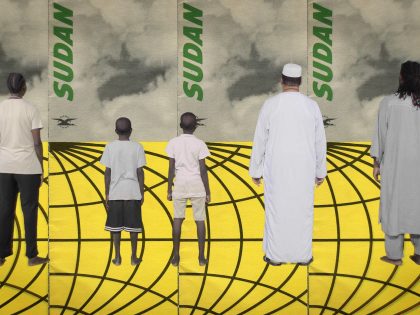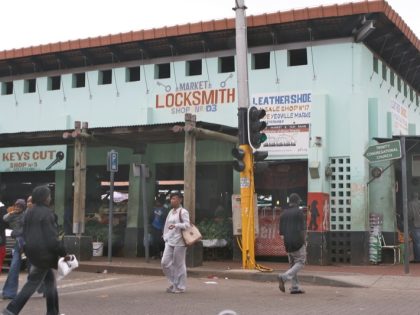The values of David Goldblatt

David Goldblatt. Image via Goodman Gallery
Inseparable from the photographic images of world-renowned South African photographer David Goldblatt, are values. Values, like waves of light, are in some ways absorbed as the social information of a photograph, and in others reflected back at the viewer. Goldblatt, whose imagework blurs the lines between documentary and fine art, frequently speaks of values in his public commentary. This mantra of values comes from the lifetime he has spent photographing the ways in which values are woven into the fabric of South African society. In contemplating his legacy, a new film, Goldblatt, turns the lens around to reveal and interrogate the values embodied by the photographer himself. Directed by Daniel Zimbler, a South African filmmaker who lives and works in New York City, Goldblatt presents the life and career of the legendary photographer through a decade of filming him at work and through interviews with art critics and fellow visual artists.
In the film, we see that Goldblatt is getting on in years – he is in his mid-80s – but still making images. Over the course of his career, Goldblatt has produced many significant bodies of work that depict uniquely South African social environments. Known for capturing the conditions that led to historic events rather than the events themselves, the film acts in part as a retrospective for Goldblatt’s major projects, showcasing his signature meditative approach to the documenting of declining mining towns, Apartheid-era Afrikaner communities, suburban Johannesburg architecture, township living and the dusty landscapes of the Karoo. Rich with resonant luminance, Goldblatt’s images have a way of highlighting the lines of contrast visible when highly racialized cultures envelop a society’s people, structures and landscapes. Through the photographing of mundane moments lasting fractions of a second, Goldblatt’s collections of images collectively carry the charge of haunting moments in history that seem both far away and very near at the same time.
In telling the story of Goldblatts’s photographic life, the film drives with him in camper van across South Africa in search of images, and explores his studio where he digs through old keepsakes including snapshots from his school days in the 1940s and a heavily scratched mining helmet. As Goldblatt reflects on his work, he offers insights into his personal philosophies of image-making; he doesn’t shoot for a particular audience, he aims to be uncaring as a photographer, and he’s not swayed by being considered an important photographer. Yet, the film does well to reveal that these attitudes are complicated within his psyche. We see that Goldblatt mistrusts the ability of non-South Africans to read the coded language of his images, he refers to himself as an “international artist” when he wants something done for him, and his dispassionate approach has led him to ultimately feel that his work has been “partial and superficial.”
It is Goldblatt’s approach to his photography work that informs his personal politics, and the film picks up its pace as Goldblatt’s relationship to politics comes under scrutiny, especially the Apartheid years. Concerned with compromising his photographic vision, Goldblatt never documented overtly political events and operated with a general rule of never allowing his images to be used for political purposes. He speaks of being sympathetic to the anti-Apartheid cause, though kept his distance. A range of art figures are asked in the film what this distance has meant for Goldblatt’s life and legacy. Mostly white, they include the artist William Kentridge, novelist Marlene van Niekerk, writer Sean O’Toole and curator Hans Ulrich-Obrist. Marlene van Niekerk covers for Goldblatt: “I think involvement through the lens was what he protected by not becoming politically more involved.” Black photographers are inconspicuous in this debate. Zanele Muholi, who represents a younger generation, speaks kindly of Goldblatt at the start of the film, though her contribution is brief and seems tagged on.
The most directly critical voice is that of Omar Badsha, a photographer identified variously with black consciousness, trade unions and the mass democratic movement in his long career as a “social documentary photographer.” Badsha, with whom Goldblatt has collaborated on several projects over the years, is less flattering of Goldblatt’s political neutrality: “David’s work never challenged the state. David’s work doesn’t question the system of racism in [South Africa], because if you question it, there is no difference between the Afrikaner and English-speaking South Africans.” For Badsha, Goldblatt is a “white liberal;” a group derided for declaring opposition to Apartheid, but who often refused to take part in protest or boycott. The film notes that during the cultural boycott (when the liberation groups discouraged South African artists, especially whites, from exhibiting their work overseas), Goldblatt had a show in London in 1985, which was criticized by liberation groups. Goldblatt deemed it censorship. Badsha thinks the decision to hold the London exhibition was “naïve.”
The transition to a democratic South Africa, brought new freedoms, but it did not dismantle social and economic power disparities that have allowed white capitalist patriarchy to live on. This context is compounded in the practice of photography by the already fraught power relationship between photographer and those who appear in their images. A telling contemporary scene in the film lets us observe Goldblatt’s process for shooting in a township. The scene begins with him tracking down a woman he had photographed in the 1970s. With the help of a fixer and some community members, he locates the woman. Goldblatt greets her cordially in Afrikaans, shows her the old photograph he had taken and asks to take a new one. The woman politely inquires as to what he does with all the photographs he takes. Goldblatt grins and proudly mentions exhibiting them in Europe and South Africa. She responds, without missing a beat: “But you take our photos, you give us nothing – we’re lying hungry here man.” They eventually agree on compensation – it is unclear how much – and he suggests she sit in the kitchen for the portrait to mimic the image of her taken years earlier. She tries to object to the location because of a broken stove, but he insists on the kitchen and when it’s time to take the shot he tells her how to look. The interaction reveals the dominance of a polite, but layered power in Goldblatt’s method as well as the dubiousness of veracity in the documentary tradition.
Later on in the film, in a moment of reflective melancholy, the voice of the artist William Kentridge notes that a photograph is really about the person who makes it. This in an important reminder from the film’s producers that Goldblatt’s photographs, with their masterful composition of quiet social topography, have always responded to his own vision of life in South Africa. He has been fortunate that for many years his vision has carried a legibility that resonated with information power brokers in South Africa and beyond.
However, the landscape of information distribution and consumption is shifting and there are new voices bringing different dimensions to the story of the South Africa’s evolution. Many of those photographic voices, like that of Muholi, have been trained at the Market Photo Workshop, a project Goldblatt helped found in 1989. What began as a short-term training course has grown into a serious photography school and exhibition space that targets students from diverse lower income backgrounds. Market Photo has been a way for Goldblatt to share his passion for images through fellowship and is an important part of his legacy, though the institution is strangely not mentioned in the film.
By displaying Goldblatt’s controversial pursuit of a dispassionate photographic vision and the revelation that he has a collection of never-before exhibited nude images, the film highlights that he is often self-limiting in what it means to be Goldblatt, or what qualifies something as a Goldblatt image. In acknowledging these limitations, he speaks to the consequences of isolation and loneliness that he has experienced over the years, admitting that he wishes he could go deeper in his connections, but doesn’t know how. Hinted at in the film, though not fully explored, are the costs of his itinerant obsession felt by family. Goldblatt’s wife, Lily, expresses she would have preferred he had a more stable career (their children are never heard from). In the aesthetic realm, Goldblatt laments that in South Africa he can never just photograph a landscape as a landscape, though he’s aware that the question of values in such contested space can never be escaped. The values he so often gestures at in the people and places in South Africa are projected from him as well.
Zimbler’s film is effective in traversing multiple dimensions of Goldblatt’s life and legacy. Goldblatt’s technical mastery of his tools and the insightfulness of his observant eye imbue his images with a historical importance that is difficult to deny. Still fevered by the pursuit of his vision, recognizing a shift in the tonality of the social landscape, Goldblatt even documented the recent removal of the colonial Cecil Rhodes statue at the University of Cape Town campus that was a result of the student-driven #RhodesMustFall movement. In Goldblatt’s momentous image of the statue’s removal, he captures a wide angle of Rhodes being hoisted by a crane, surrounded by students with their arms raised, cell phone cameras in hand. In the film, Goldblatt jokes that the students were so busy raising their arms in this strange “ritual” that nobody was actually looking at the event. Yet, as the only one supposedly looking, he forgets that it was the students who brought Rhodes down.
*This review is part of our round up of the films screened at Encounters International Documentary Festival, which took place in Cape Town and Johannesburg from 1-11 June.



















